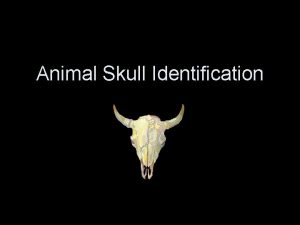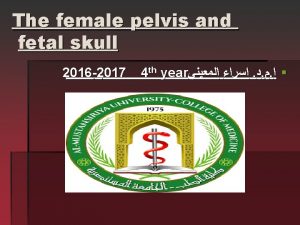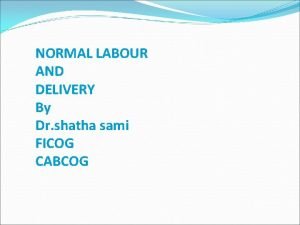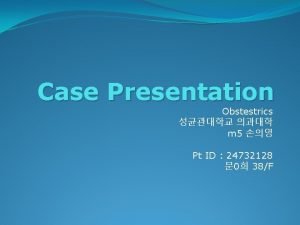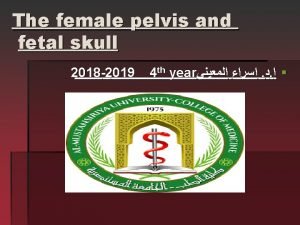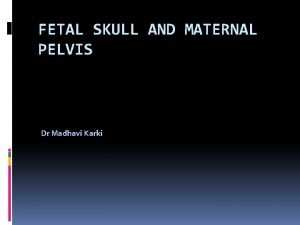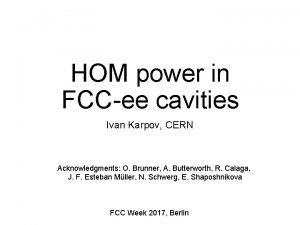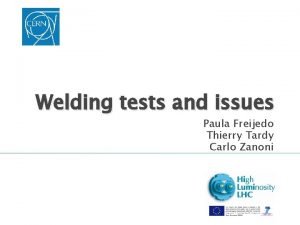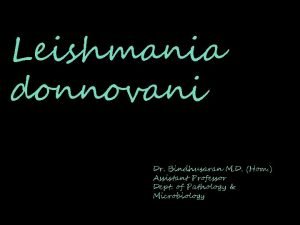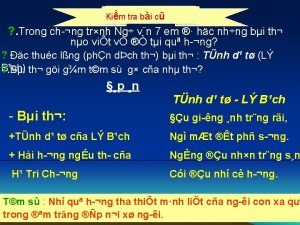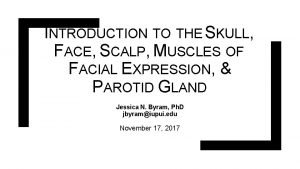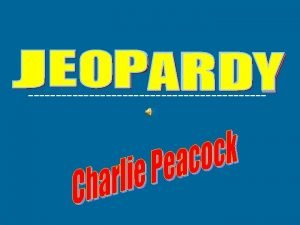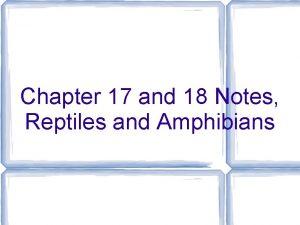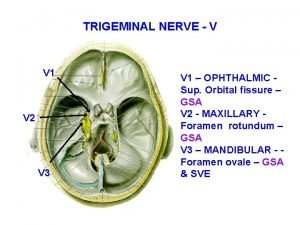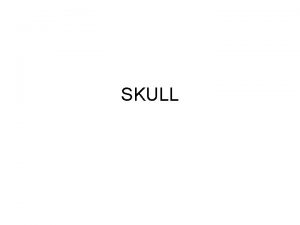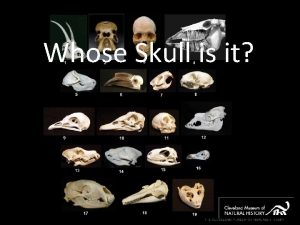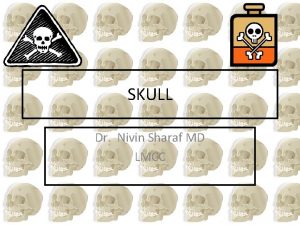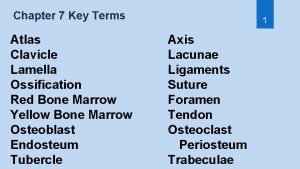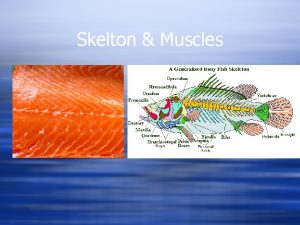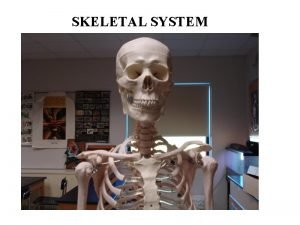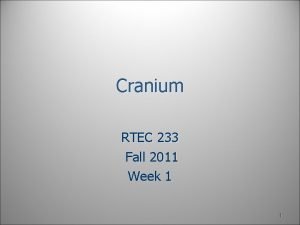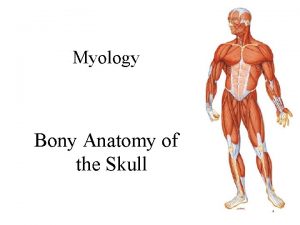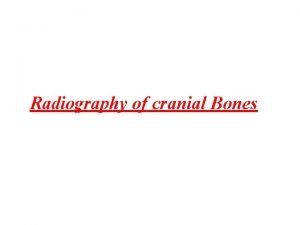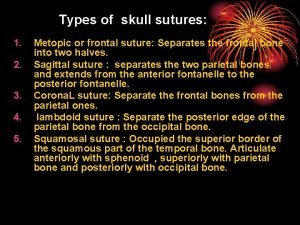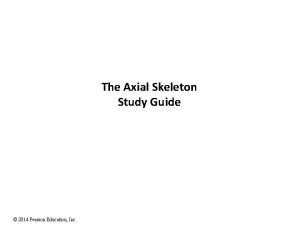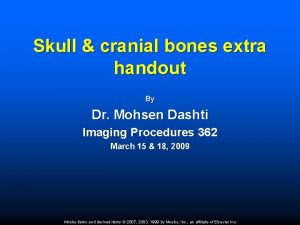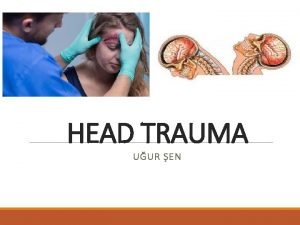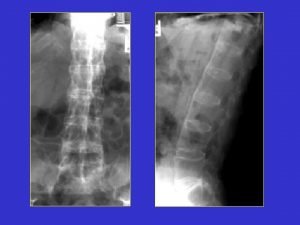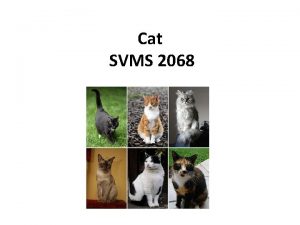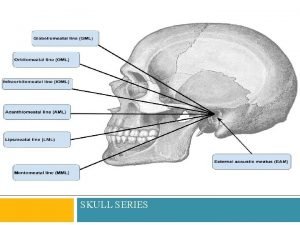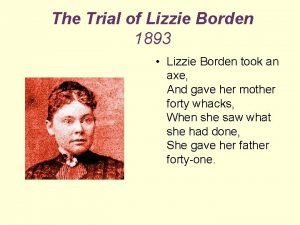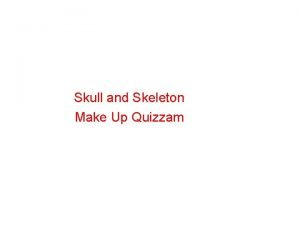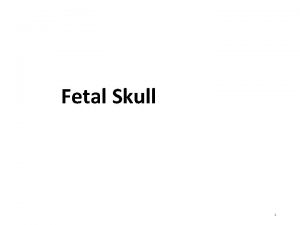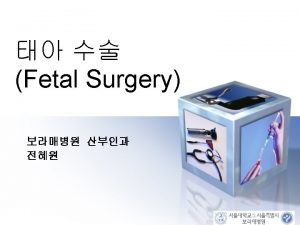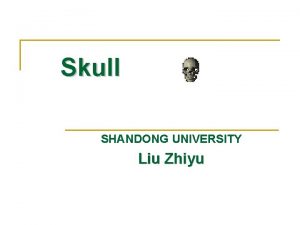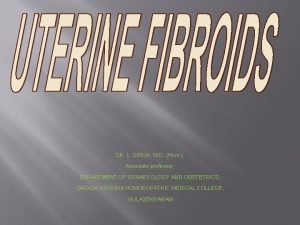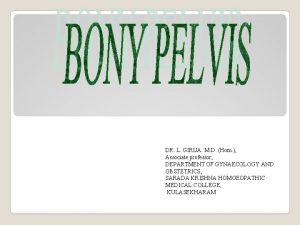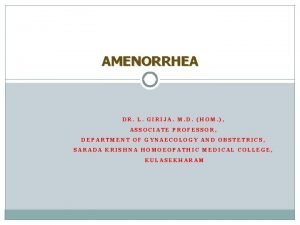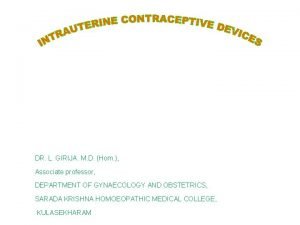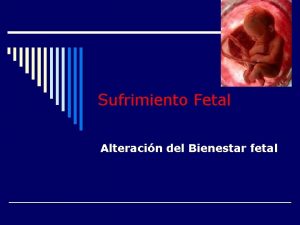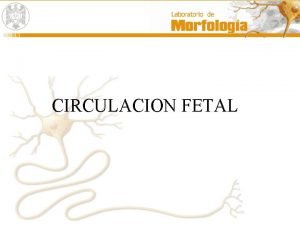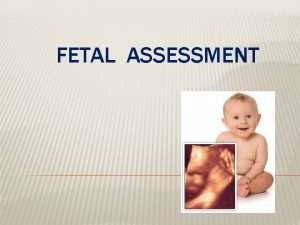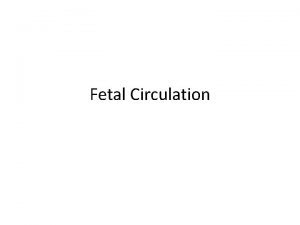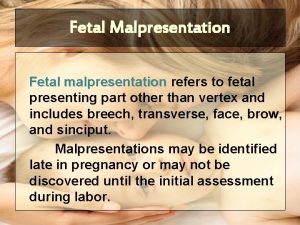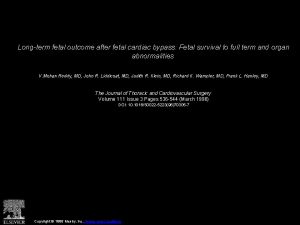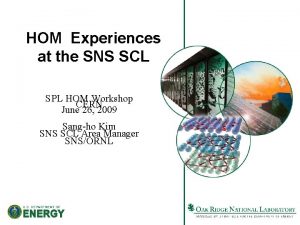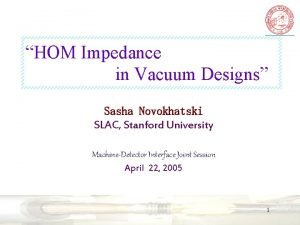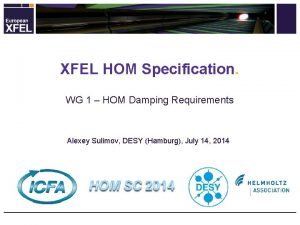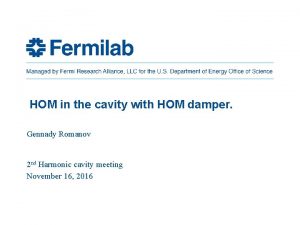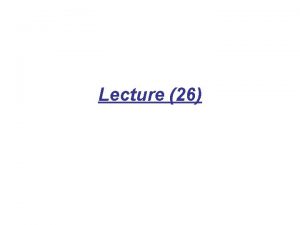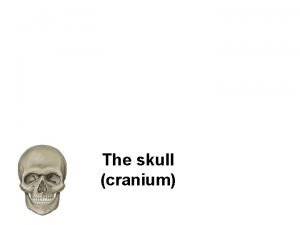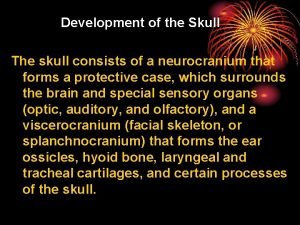FETAL SKULL DR L GIRIJA M D Hom










![BROW lies between anterior fontanelle [bregma] & coronal sutures till root of nose & BROW lies between anterior fontanelle [bregma] & coronal sutures till root of nose &](https://slidetodoc.com/presentation_image_h2/93a518e117f072f1feb106c82d7dc09c/image-11.jpg)





![SAGITTAL [longitudinal] SUTURE lies across the vault of the skull in the mid line SAGITTAL [longitudinal] SUTURE lies across the vault of the skull in the mid line](https://slidetodoc.com/presentation_image_h2/93a518e117f072f1feb106c82d7dc09c/image-17.jpg)




![FONTANELLE - Anterior fontanelle {bregma} Posterior fontanelle {lambda} Sagittal fontanelle Temporal [gasserian] fontanelles Among FONTANELLE - Anterior fontanelle {bregma} Posterior fontanelle {lambda} Sagittal fontanelle Temporal [gasserian] fontanelles Among](https://slidetodoc.com/presentation_image_h2/93a518e117f072f1feb106c82d7dc09c/image-22.jpg)



























- Slides: 49

FETAL SKULL DR. L. GIRIJA. M. D. (Hom. ), Associate professor, DEPARTMENT OF GYNAECOLOGY AND OBSTETRICS, SARADA KRISHNA HOMOEOPATHIC MEDICAL COLLEGE, KULASEKHARAM

It is important to know the anatomical aspects Of fetal skull which has the obstetric significance, because the identification of it’s areas, sutures & fontenelles helps to identify the position of head in labour. At the same way the diameters of the skull are concerned to the mechanisum of labour.


The FETAL SKULL is made of bones which forms the VAULT and the BASE. VAULT is made of thin, compressible And pliable flat bones. BASE is made of rigid and incompressible bones.

The bones which forms the skull are – - 2 Frontal bones 2 Parietal bones 2 Temporal bones The wings of sphenoid 1 Occipital bone

For the obstetrical importance, the fetal skull is divided into various areas like – a. Vertex b. Brow c. Face d. Occiput

Like that it poses SUTURES. They are - Frontal suture - Sagittal suture - Coronal sutures - Lambdoid sutures - Temporal sutures

Wide gap in the suture line is called FONTANELLE. There are 6 fontanelles. - Anterior fontanelle {bregma} Posterior fontanelle {lambda} Sagittal fontanelle Temporal [gasserian] fontanelles Among them 1 & 2 has obstetric significance.

Areas a. Vertex b. Brow c. Face d. Occiput

VERTEX is a diamond shaped area between the anterior & posterior fontenelles & the parietal eminences. Boundaries Ant – bregma & coronal sutures Post – post fontenel & Lambdoid sutures Lat - arbitrary lines through parietal bones.
![BROW lies between anterior fontanelle bregma coronal sutures till root of nose BROW lies between anterior fontanelle [bregma] & coronal sutures till root of nose &](https://slidetodoc.com/presentation_image_h2/93a518e117f072f1feb106c82d7dc09c/image-11.jpg)
BROW lies between anterior fontanelle [bregma] & coronal sutures till root of nose & supra orbital ridges

FACE lies between root of the nose, supra orbital ridges till the junction of the floor of the mouth with neck.

OCCIPUT is the bony prominance lies behind the posterior fontanelle. SUBOCCIPUT is the junction of foetal neck and occiput{nape of neck}

�Sinciput �Mentum �Sub Mentum – Fore head region of the foetal head. - Chin – Junction between the neck �Vertical point �Frontal point – Centre of sagital suture - Root of the nose & chin

Sutures - Frontal suture Sagittal suture Coronal sutures Lambdoid sutures Temporal sutures

FRONTAL SUTURE is situated between the frontal bones.
![SAGITTAL longitudinal SUTURE lies across the vault of the skull in the mid line SAGITTAL [longitudinal] SUTURE lies across the vault of the skull in the mid line](https://slidetodoc.com/presentation_image_h2/93a518e117f072f1feb106c82d7dc09c/image-17.jpg)
SAGITTAL [longitudinal] SUTURE lies across the vault of the skull in the mid line between two parietal bones.

CORONAL SUTURE lies between parietal and frontal bones on eithar sides. It separate both frontal & parietal bones.

LAMBDOID SUTURE is seen between parietal & occipital bones.

TEMPORAL SUTURES lies between inferior margin of parietal bone & temporal bone on eithar side.

Importents of sutures �It permits the gliding movement of one bone over the other during moulding of the head when the head passes through the pelvis during labour. �Digital palpation of sagital suture during labour gives clue to - manner of engagement, (asynclitism, syncli) - degree of internal rotation of head & - degree of moulding
![FONTANELLE Anterior fontanelle bregma Posterior fontanelle lambda Sagittal fontanelle Temporal gasserian fontanelles Among FONTANELLE - Anterior fontanelle {bregma} Posterior fontanelle {lambda} Sagittal fontanelle Temporal [gasserian] fontanelles Among](https://slidetodoc.com/presentation_image_h2/93a518e117f072f1feb106c82d7dc09c/image-22.jpg)
FONTANELLE - Anterior fontanelle {bregma} Posterior fontanelle {lambda} Sagittal fontanelle Temporal [gasserian] fontanelles Among them only 1 & 2 has obstetric significance.

ANTERIOR FONTANELLE {bregma} Formed by joining four sutures in the midline Sutures are – Frontal, sagittal & coronal on sides Shape - Diamond Diameters - both AP & T diameters are approximately 3 cm Floor - made of membranewhich ossifies 18 months after birth. It denote the degree of flexion of head during P/V examination. It promote moulding of head during labour.

POSTERIOR FONTANELLE {lambda} Formed by joining 3 sutures. Sutures – sagittal & lambdoid on either side Shape - Triangular Floor - membranous, but bony at term. It denote the position of head in relation to maternal pelvis.

Sagittal fontanelle - Mostly it may not present. But if present, It can occur on the sagital suture at the junction of ant 2/3 & post 1/3 - Temporal [gasserian] fontanelles -

DIAMETERS OF SKULL

The engaging DIAMETERS OF SKULL depend on the degree of flection present. Antero posterior diameters are a. Suboccipito bregmatic diameter b. Suboccipito frontal diameter c. Occipito frontal diameter d. Mento vertical diameter e. Submento vertical diameter f. Submento bregmatic diameter B. Transverse diameters are a. Biparietal diameter b. Super subparietal diameter c. Bi-temporal diameter d. Bi-mastoid diameter A.

A. Antero posterior diameters a. Suboccipito bregmatic - 9. 5 cm {3 ¾”} - Extend from nape of neck to the centre of bregma - Attitude of head is complete flection - Presentation is vertex

b. Suboccipito frontal - 10 cm {4”} - Extends from nape of the neck to the mid point of frontal suture or [centre of sinciput] - Attitude is incomplete flexion - Presentation is vertex

c. Occipito frontal - 11. 5 cm{4 1/2”} - Extends from occipital eminence to the root of the nose [glabella ] - Attitude of the head is marked deflection. - Presentation is deflexed vertex.

d. Mento vertical - 14 cm {5 1/2”} - Extend from chin to centre of the sagital suture - - Attitude of the head is partial extension - Presentation is brow

e. Submento vertical - 11. 5 cm {4 ½”} - Extend from junction of floor of the mouth & neck to the highest point on the sagittal suture - Attitude of the head is incomplete extension - Presentation is face

f. Submento bregmatic - 9. 5 cm {3 ¾”} � - Extend from the chin to the middle of bregma - Attitude of the head is complete extension � - Presentation is face

B. Transverse diameters are a. Biparietal diameter b. Super subparietal diameter c. Bi-temporal diameter d. Bi-mastoid diameter

�a. Biparietal diameter - 9. 5 cm {3 3/4”} - Extends between two parietal eminances

�b. Super subparietal diameter - 8. 5 cm (3 ½”) - Extends from a point placed below one parietal eminance to a point placed above the other parietal eminance of the opposite side.

c. Bi-temporal diameter - 8 cm (3 ¼”) - Between two lower ends of the coronal sutures.

�d. Bi-mastoid diameter - 7. 5 cm (3”) - Distance between the tips of the mastoid processes. - It is an incompressible diameter. - Impossible to reduce it’s length obstetrically.

Foetal head Circumference

Circumferences �Foetal head Circumference of vertex & face passes through the true pelvis. �This Circumference of Foetal head passes through the pelvis is the GIRDLE OF CONTACT. � True pelvis permits to pass various vertex or face presentations with GIRDLE OF CONTACT 9. 4 – 11. 25 cm. �But brow presentation (incomplete extension) with mento vertical diametre of 13 cm cannot pass through it. �Co the Circumference differs according to the attitude of head.


Attitude of Plane of {Tr+Ap d} shape the head engagement Complete flexion Deflexed Incomplete extension {brow} Complete extension Biparital 9. 5+ round Subocc breg 9. 5 Biparital 9. 5 + occi oval front 11. 5 Biparital 9. 5 + ment vert 14 cm Big oval Biparital 9. 5 + subment breg 9. 5 round Circumfer ence in cm 27. 5 (11”) 34 cm (13 ½”) 37. 5 cm (15”) 27. 5 cm (11”)

Clinical importance of sutures & fontanelles �Palpation of sagittal suture with fontanelles in labour can identify the attitude & position of vertex in Vertex presentation. �Overlapping of cranial bones signifies the moulding of head. �extreme Overlapping in labour denotes foetal death.

Vertex Face brow Presenting parts of Foetal skull

Foetal skull changes in labour Moulding Caput succedaneum

Moulding It is the alteration of the shape of the fore coming head with minimal reduction in size due to resistance of girdle of contact while passing through the resistant birth passage during labour. Alteration of head with minimal reduction in size of 4 mm in skull diameter is common in normal delivary. Moulding disappears within few hours after birth.

Mechanism – There is compression of the engaging diameter of the head with corresponding elongation of the diameter at Rt angle to it. ct ta on fc eo rdl Gi

Gradings There are 3 grades Grade I - bones touching but not overlapping Grade II - overlapping but easily seperated Grade III - fixed overlapping

Caput succedaneum �It is the formation of swelling due to stagnation of fluid in the layers of the scalp beneath the girdle of contact. �Girdle of contact can be either bone dilating cervix or vulval ring Swelling is boggy, diffuse & not limited to the suture lines. It appears after rupture of the membranes. With increasing flexion, the caput is placed more posteriorly. It disappears spontaneously within 24 hrs of birth.
 Herbivore skull identification
Herbivore skull identification Clinical pelvimetry
Clinical pelvimetry Fetal skull
Fetal skull Onset of labour
Onset of labour Molding of fetal skull
Molding of fetal skull N
N Diameters of fetal skull
Diameters of fetal skull Maternal pelvis and fetal skull
Maternal pelvis and fetal skull Life opportunity meeting
Life opportunity meeting Ivan hom
Ivan hom An đéc xen
An đéc xen Hom tardy
Hom tardy Leishmanioma
Leishmanioma Hôm sau
Hôm sau Tinthac net hôm nay
Tinthac net hôm nay Hôm sau
Hôm sau Hôm sau
Hôm sau Soi sáng
Soi sáng Orbital complex bones
Orbital complex bones Fissura petrotympanica
Fissura petrotympanica Prefix related to bones
Prefix related to bones Reptile circulatory system
Reptile circulatory system Mandibular foramen
Mandibular foramen Nasal silling/guttering skull
Nasal silling/guttering skull Gudea
Gudea Norma frontalis of skull
Norma frontalis of skull Are raccoons herbivores carnivores or omnivores
Are raccoons herbivores carnivores or omnivores Lmcc objectives
Lmcc objectives Bones of the skull
Bones of the skull Asian vs caucasian skull
Asian vs caucasian skull Hagfish skull
Hagfish skull Skull labeled
Skull labeled Hyposthenic and asthenic
Hyposthenic and asthenic Cotton wool appearance of skull
Cotton wool appearance of skull Lacrimal bones
Lacrimal bones Crista gali
Crista gali Skull sutures
Skull sutures Axial skeleton study guide
Axial skeleton study guide Appendicular skeleton figure 5-8
Appendicular skeleton figure 5-8 Hyposthenic and asthenic
Hyposthenic and asthenic Traumatic subdural hematoma
Traumatic subdural hematoma Cotton wool appearance of skull
Cotton wool appearance of skull Cat skull 3/4 view
Cat skull 3/4 view Skull fracture types
Skull fracture types Nasal silling guttering
Nasal silling guttering Arms movement
Arms movement Pa caldwell facial bones positioning
Pa caldwell facial bones positioning Skull color wheel
Skull color wheel Lizzie borden and bridget sullivan
Lizzie borden and bridget sullivan Eye bones
Eye bones
